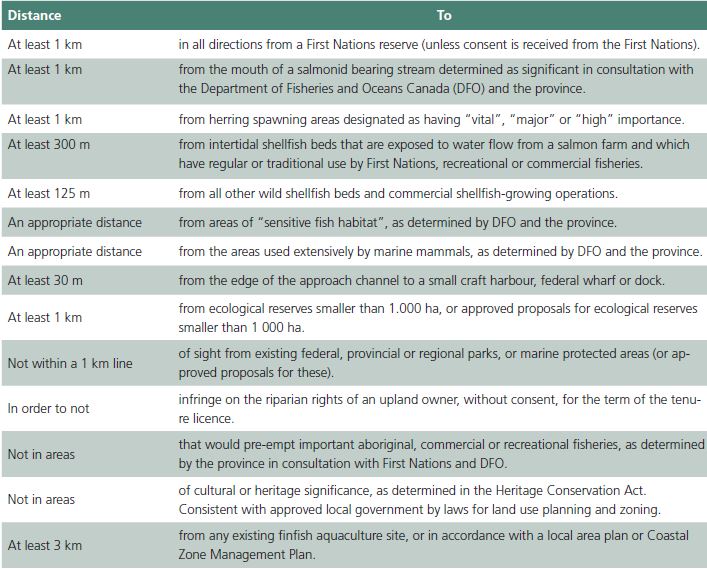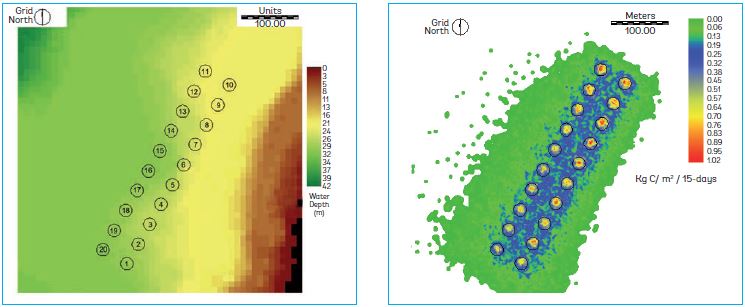5.2. Detailed estimation of carrying capacity for sites
Assessment of carrying capacity at the site level is much more developed than the assessment at the zonal or area scales, especially for the marine environment, but nonetheless still contends with many of the complexities outlined above when considering production impacts on water quality and sediments, and resolving what an acceptable level of production is.
In the majority of cases, sitelevel carrying capacity models estimate nutrient inputs to the environment and assess impacts on sediments, on the water column, or both. More often than not, models assess these impacts against minimum environmental quality standards, often defined
TABLE 10. Distances between salmon aquaculture sites and other areas in British Columbia, Canada

Source: Dow (2004).
nationally through scientific endeavour and (in some cases) set specifically by regulators, which then set a maximum production level, often derived through an iterative process. Some models take this further by assessing profitability to ensure the ecological limits defined are profitable for the farmer as well.
Site carrying capacity models can range from simple mathematical calculations to more complex integrated processes that require specialized software. In perhaps the simplest form, model equations produce a mass balance for many different parameters, the most widely used being nitrogen and phosphorus concentrations into and from aquaculture systems. There is a determination of how much of a specific nutrient enters or is removed from a local (site) system and analysis of the consequences of that input/removal for the waterbody.
A relatively simple example of a nutrient-based carrying capacity model was developed by Halide, Brinkman and McKinnon (2008) and is vailable online at http://epubs.aims.gov.au/handle/11068/7831; it is in part based on the MOM model (see below).
Other models are significantly more complex, and a few only are summarized here to indicate what is possible. The MOM model (Ervik et al., 1997; Stigebrandt, 2011) defines, among other things, changes to sediment oxygen concentration from the deposition of particulate matter for a certain level of production, which is compared with a minimum environmental quality standard. Additionally, the Farm Aquaculture Resource Management (FARM) model assesses species growth and the likely impacts of that growth on environmental conditions (Ferreira, Hawkins and Bricker, 2007; Cubillo et al., 2016).
Another approach to carrying capacity estimation at the farm scale uses depositional models (Cromey, Nickell and Black, 2002; Corner et al., 2006; Ferreira, Hawkins and Bricker, 2007; Ferreira et al., 2008a, 2008b; Cubillo et al., 2016), which predict the accumulation of particulate outputs from fish cage aquaculture in the sediments below fish cages (Figure 3) or other aquaculture systems, and can be used in local-scale assessment of the effects of fish cages on sensitive demersal flora and fauna. The DEPOMOD model (Cromey, Nickell and Black, 2002) is a particle tracking model for predicting flux and resuspension of particulate waste material and assesses the associated benthic community, the outcome of which can be a definition of an allowable zone of effect; see Cromey (2008). The ORGANIX model (Cubillo et al., 2016) can be used to evaluate settlement of wastes, and combined with the FARM model can assess the local impacts of multiple species, individually, and in combination in an integrated multi-trophic aquaculture (IMTA) system.
To estimate carrying capacity of shellfish and seaweeds, which do not pollute through nutrient outfall, but do compete with wild organisms for food, nutrients and oxygen, models should calculate the amount of shellfish that can be grown in a particular site without starving either the cultured or wild animals in the area. Ferreira (1995), Nobre et al. (2005, 2011), and Ferreira et al. (2008a) describe a carrying capacity model applicable for such systems. EcoWin is based on hydrodynamics, suspended matter transport, nitrogen cycle, phytoplankton and detrital dynamics, shellfish growth and human interaction and has been field tested in a number of locations, notably in Ireland (Ferreira, Hawkins and Bricker, 2007) and China (Ferreira et al., 2008b).
An efficient production plan for aquaculture needs to consider carrying capacity and site characteristics to determine how much production can be accommodated in a particular location and, consequently, the amount of money that could be generated in order to achieve sustainability. Crowded production units mean that the stock can suffer from crowding stress, which lowers productivity (Figure 4), in addition to the disease transfer risks outlined previously. Figure 4 shows the evolution of productivity for three fish species in Chile over time, with dips in productivity associated with overcrowding, particularly of Atlantic salmon (Salmo salar). The decrease was critical in 2008 and 2009, and at this time saw the introduction of new regulations that established area management and coordinated fallowing periods, which resulted in improved productivity for all three species.Achieving production within the carrying capacity of the local system means managing for maximum productivity rather than maximum standing stock (e.g. the number of fish in the water at any one time), which will reduce pollution and costs while ensuring the welfare and maximizing the growth rate of the stock.
Carrying capacity estimation for individual farm sites is usually undertaken as part of the environmental impact assessment (EIA) and the licencing procedure (FAO, 2009). A fair and equitable licencing procedure, an EIA and an assessment of carrying capacity enable the setting of limits on farm size, including permits to discharge nutrients or other wastes to a waterbody, to ensure that there is no deterioration of water quality.
This is particularly important for fed culture systems that generate wastes, but also for extractive species where wild stocks also need to be maintained.
For project planners at all levels, estimating carrying capacity is crucial to ensure overall sustainability of farms, and a number of modelling tools are available
FIGURE 3. Output from a particulate waste distribution model developed for fish culture in Huangdun Bay, China, using GIS, which provides a footprint of organic enrichment beneath fish farms

Source: Corner et al. (2006).
to be able to better understand what the limits are (see Annex 4). Models are generally the domain of knowledgeable specialists, and it is recommended that a suitable consultant conversant with appropriate models be engaged to develop systems relevant to specific circumstances.